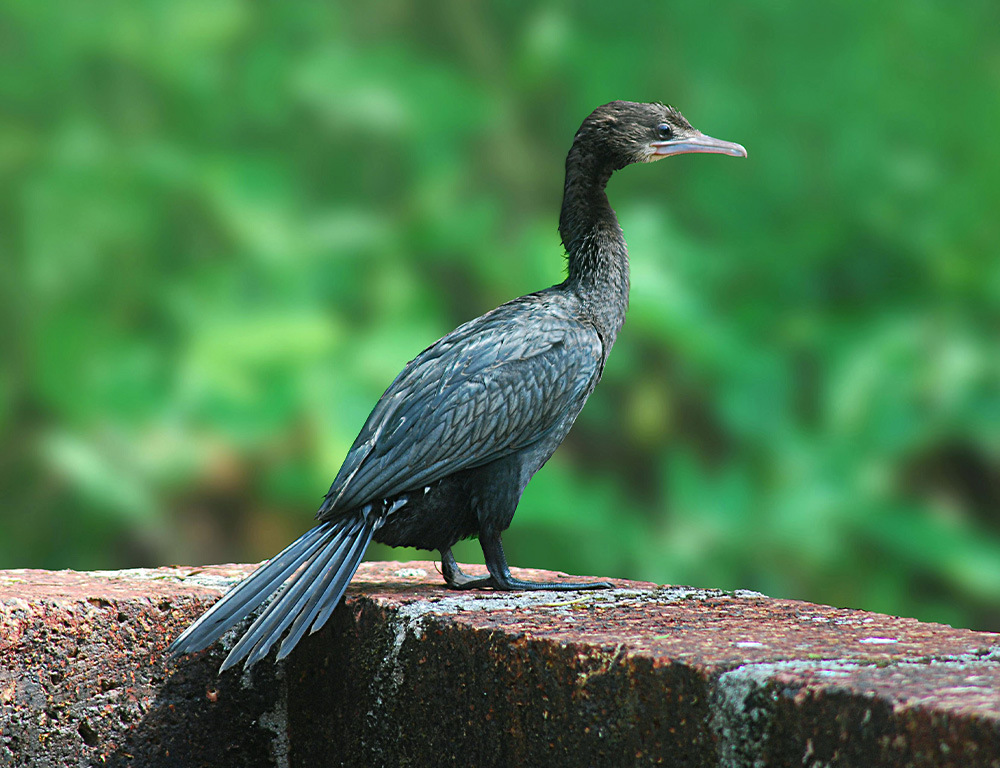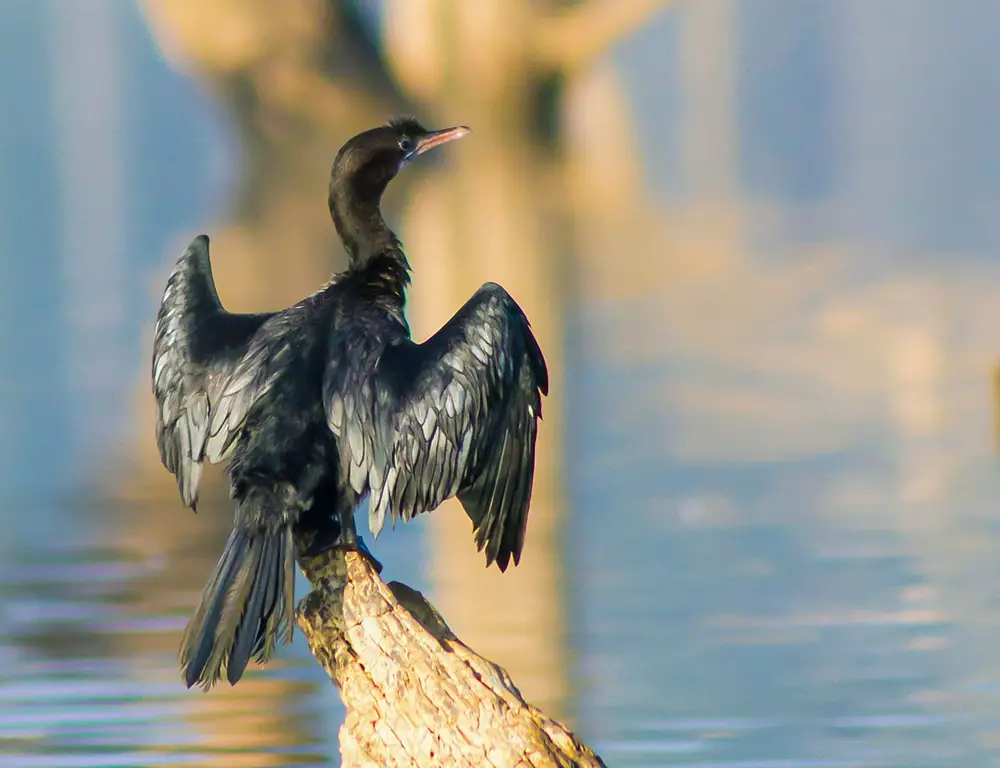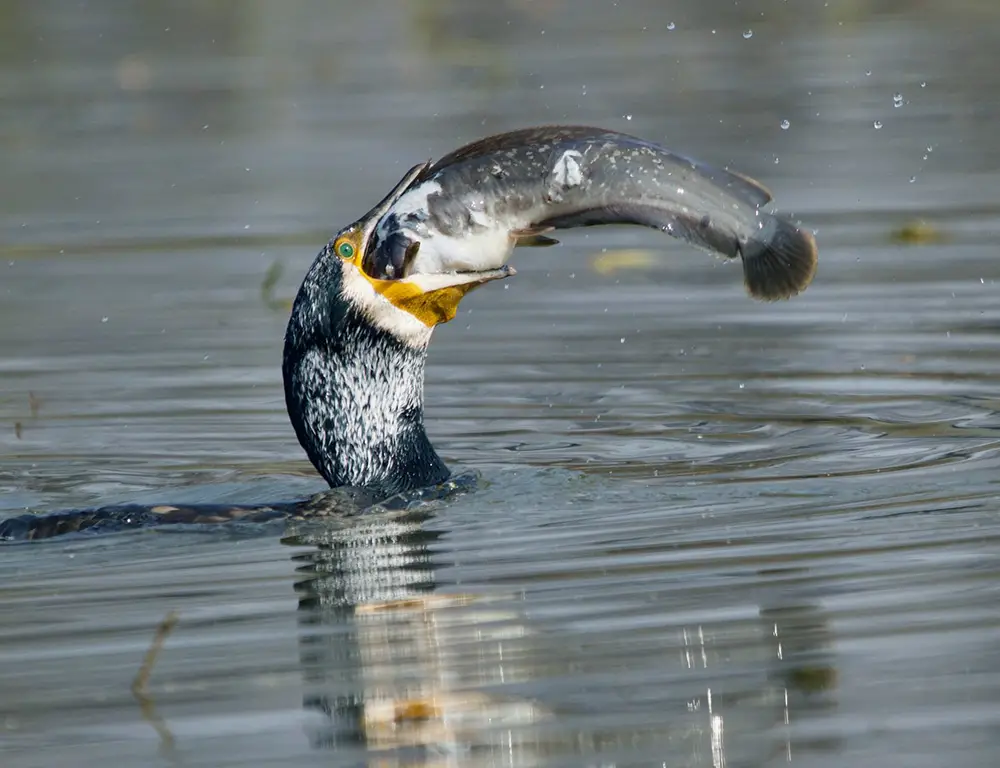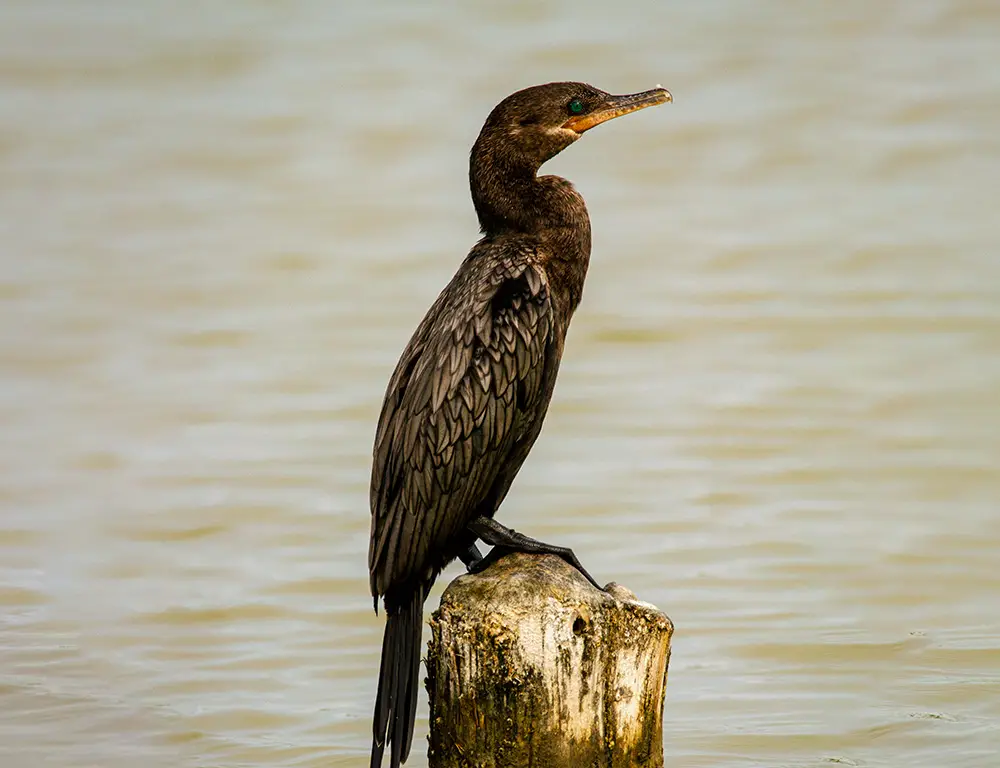Sitting at the crossroads of beauty and wildlife, the Indian Cormorant is a fascinating bird species that has captivated the interest of birdwatchers and ornithologists alike.
Native to parts of the Indian subcontinent and Southeast Asia, this waterbird isn’t your average backyard visitor. Instead, it’s a master fisher with an enviable skillset that includes diving underwater for extended periods to catch its prey.
The Indian Cormorant goes by many names such as “Indian Shag” or “Phalacrocorax fuscicollis”. It’s distinct from other cormorants due to its slender body structure, long tail, and glossy black plumage, making it easily identifiable in its native habitats.
This unique bird has adapted remarkably well to both inland water bodies and coastal areas.
Adaptability is vital when it comes to survival in nature. For these birds, it’s no different. They’ve survived and thrived in varied ecosystems – from freshwater lakes and marshes to mangroves and estuaries.
This versatility, combined with their extraordinary fishing abilities, make the Indian Cormorant a captivating subject for study and admiration.

Physical Characteristics of the Indian Cormorant
The Indian Cormorant, scientifically known as Phalacrocorax fuscicollis, exhibits a range of physical characteristics that distinguish it within the avian world:
Size
Indian Cormorants typically measure around 63 centimeters (24.8 inches) in length from beak to tail, making them medium-sized birds.
Weight
On average, these birds weigh roughly 1 kilogram (2.2 pounds).
Coloration
Their plumage is primarily glossy black with hints of brown. Under sunlight, their feathers may display an iridescent greenish-blue sheen. During the breeding season, their necks turn glossy black, and their heads may exhibit purplish-blue shades.
White tufts may emerge on their heads and throat regions during this period.
Beak
Indian Cormorants have long, slender bills that are distinctly hooked at the end. This specialized beak shape aids in catching prey underwater, allowing for precise grasping and securing of fish, frogs, and crustaceans.
Feet
Similar to many aquatic birds, Indian Cormorants have webbed feet, which facilitate swimming and diving activities. The webbing between their toes enhances propulsion through water, enabling agile movement while hunting for prey underwater.
Wingspan
They possess a wingspan ranging from approximately 105 to 127 centimeters (41 – 50 inches), giving them significant span for flight and maneuverability over water.
Body Structure

Indian Cormorants have sleek, streamlined bodies with long necks and elongated tails. This design enables efficient movement both in air and water, contributing to their prowess as skilled fishers.
Sexual Dimorphism
While there may be subtle differences between males and females, such as size or coloration during the breeding season, Indian Cormorants generally exhibit minimal sexual dimorphism in physical appearance.
Habitat and Distribution of the Indian Cormorant
The Indian Cormorant (Phalacrocorax fuscicollis) is a waterbird species native to the Indian subcontinent and parts of Southeast Asia. This species exhibits adaptability to various aquatic environments, contributing to its widespread distribution across the region.
Habitat
Indian Cormorants are commonly found to inhabit diverse aquatic habitats, including:
- Freshwater Wetlands: They thrive in habitats such as swamps, marshes, lakes, reservoirs, and large ponds. These areas provide abundant fish and other aquatic prey for the cormorants.
- Coastal Regions: Indian Cormorants also frequent coastal areas, including estuaries, mangroves, and tidal flats. These coastal habitats offer additional foraging opportunities and nesting sites for the birds.
- Manmade Water Bodies: They are known to adapt to human-altered environments, often utilizing urban canals, ponds, and rivers in urban areas where natural wetlands may be scarce or degraded.
Distribution
The Indian Cormorant exhibits a broad geographical range across the Indian subcontinent and Southeast Asia. Its distribution includes countries such as India, Nepal, Sri Lanka, Pakistan, Bangladesh, Myanmar, Thailand, and Cambodia.
The extent of its presence varies in different regions:
- India: Indian Cormorants have an extensive presence throughout India, inhabiting various states and regions.
- Nepal: While not as abundant as in India, Indian Cormorants are commonly found in Nepal, particularly in wetland areas.
- Sri Lanka: They have a widespread distribution across Sri Lanka, utilizing both inland and coastal habitats.
- Pakistan: Their presence in Pakistan is more limited than in other countries.
- Bangladesh, Myanmar, Thailand, Cambodia: Indian Cormorants are common in these countries, occupying freshwater and coastal habitats.
Behavior and Diet of the Indian Cormorant

The behavior and diet of the Indian Cormorant (Phalacrocorax fuscicollis) reflect its adaptation to aquatic environments and piscivorous feeding habits. Here’s an overview:
Fishing Techniques
Indian Cormorants are masterful fishers, employing a variety of techniques to capture prey:
- Underwater Diving: They are equipped with long necks and streamlined bodies, allowing them to dive underwater to depths of up to 2.5 meters (8.2 feet) in search of fish and crustaceans.
- Group Hunting: While they typically hunt alone, Indian Cormorants are known to form groups during certain conditions. They may coordinate with each other during group hunts, herding fish towards shallow waters where escape is less likely.
Diet Composition
The diet of the Indian Cormorant primarily consists of fish, but they are opportunistic feeders and may consume other prey items when available:
- Fish: Fish comprise most of the Indian Cormorant’s diet, accounting for approximately 70% of their food intake.
- Frogs: They may also prey on frogs, particularly in wetland habitats where these amphibians are abundant. Frogs contribute to about 20% of their diet.
- Crustaceans: Indian Cormorants are known to consume crustaceans such as crabs and shrimp, comprising roughly 10% of their food intake.
Nesting Behavior
During the breeding season, which typically occurs between June and August, Indian Cormorants engage in fascinating nesting behaviors:
- Nest Construction: They build nests high in trees or on cliffs near bodies of water, using materials such as sticks, grass, and seaweed.
- Cooperative Nesting: Both males and females contribute to nest building, showcasing a cooperative effort in preparing their nesting sites.
- Parental Care: Once the eggs are laid, both parents share incubation duties and feed the hatchlings once they emerge.
Conservation Status of the Indian Cormorant

The conservation status of the Indian Cormorant (Phalacrocorax fuscicollis) presents a complex situation despite its classification as “Least Concern” by the International Union for Conservation of Nature (IUCN).
While this classification may suggest a relatively stable population, the species faces significant threats that warrant attention and action.
Habitat Loss and Degradation
One of the primary concerns for Indian Cormorants is habitat loss and degradation, particularly in wetland areas. Encroachment of wetlands for agricultural expansion, urban development, and infrastructure projects has diminished suitable bird nesting and foraging habitats.
In particular, the loss of mangrove forests poses a severe threat as these areas serve as critical nesting grounds for the species.
Population Decline
Despite its “Least Concern” status, there has been a notable decline in Indian Cormorant populations over recent decades.
Survey data indicate a significant decrease in population numbers, with estimates dropping from 250,000-1,000,000 individuals in 1990 to less than 100,000 individuals by 2010.
This decline underscores the urgency of conservation efforts to reverse the trend and ensure the species’ long-term viability.
Threats from Human Activities
Indian Cormorants face additional threats from human activities, including unintentional capture in fishing nets, pollution from oil spills and plastic waste, and disturbances to nesting sites.
These anthropogenic pressures exacerbate the challenges already posed by habitat loss and contribute to the species’ vulnerability.
Conservation Measures
To address the conservation challenges facing Indian Cormorants, several measures are imperative:
- Habitat Preservation: Efforts to preserve and restore wetland habitats, including mangrove forests and other critical nesting sites, are essential for the species’ survival.
This may involve establishing protected areas, implementing habitat management strategies, and promoting sustainable land use practices. - Legal Protection: Enforcing regulations to prevent indiscriminate netting and mitigate other human-induced threats is crucial.
Strengthening legal frameworks and implementing measures to combat habitat destruction and pollution can help safeguard Indian Cormorant populations. - Public Awareness and Education: Increasing public awareness about conserving Indian Cormorants and their habitats is vital.
Outreach, educational campaigns, and community engagement initiatives can foster greater understanding and support for conservation actions.
Conclusion
Stepping back to appreciate the Indian Cormorant, it’s clear that this bird species is an integral part of India’s diverse ecosystem.
From its distinct silhouette to its unique hunting technique, the Indian Cormorant adds a touch of marvel to the subcontinent’s ornithological landscape.
As a vital link in the food chain, these birds have a significant role in maintaining balance within aquatic ecosystems. They’re exceptional fishers, and their population’s health often reflects the overall well-being of marine life.
Yet challenges persist for the Indian Cormorant. Human activities and habitat loss pose threats to these birds’ survival. But with concerted conservation efforts, there’s hope for this fascinating bird species.
To encapsulate:
- The Indian Cormorant is an intriguing member of India’s wildlife.
- It plays a critical role in maintaining ecological balance.
- Conservation efforts are crucial to ensure its survival against human-induced threats.
Understanding and appreciating the Indian Cormorant isn’t just about valuing one species—it’s about recognizing our role in preserving biodiversity for future generations.
Every effort to conserve these birds contributes significantly towards achieving ecological harmony on our planet.